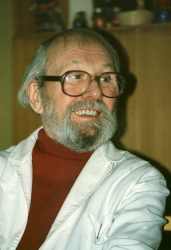Paul Schultz-Liebisch
Paul Schultz-Liebisch (born July 4, 1905 in Reinickendorf , † June 15, 1996 in Berlin-Pankow ) was a German painter and graphic artist .
Life
Until 1945
Paul Schultz-Liebisch was born as the oldest of three children in a working-class family. Like his father and grandfather, he trained as a decorative painter . Soon he began to draw. His role model, Hans Baluschek, encouraged him to keep going. He became self-taught because he couldn't afford art school. He had attached his life motto to the easel: “Life was my academy. My mentors - old masters Heinrich Zille and Hans Baluschek - remain in my grateful memories. "
Liebisch lived in Berlin-Wedding and Reinickendorf until 1944 , when it was bombed out. He lost all of his graphic and painterly work. Only fragments that had been stored with a friend were preserved.
At the age of 21 Liebisch joined the KPD , in which he was actively involved. So he could mostly only paint and draw at night. He earned his living as a stage painter in the Ufa film studio in Berlin-Tempelhof. This also gave him access to colors for his artistic work.
Under the Nazi rule he was banned from painting by the Reich Chamber of Culture. He continued to work at UFA and was politically active in the resistance group around Robert Uhrig . When the group betrayed the Gestapo , his closest friends were executed. But because they remained steadfast in the interrogation, Liebisch did not have to share this fate.
In 1944 he was drafted into the Wehrmacht , but was soon able to desert . Dutch resistance fighters hid him in a cellar in Berlin. Here he stayed until the Red Army liberated the city.
Life in the GDR
In 1946 he moved to the East Berlin district of Pankow , where he resumed his artistic activity.
Liebisch processed the war experiences from 1945 to 1949 in the graphic cycle Des Wahnsinns Ende . He depicted the bombings of Berlin, the famine in the city, the execution of his friends and the deportations of Jewish families.
As a result of the forced unification of the KPD and SPD , Liebisch became a member of the SED . At first he stayed true to his convictions and wanted to get involved in a free artistic career. He became a functionary alongside Walter Ulbricht . Its Stalinist course and a radical cultural reform prevented the free art, as Schultz-Liebisch imagined. So he resigned from the SED in 1951 and resigned from most offices. From then on, the artist was officially ignored, including being unable to take part in the major art exhibitions in the GDR after 1953. The Ministry of State Security had him observed, and trips to other western countries were not permitted. There was no exhibition ban, but he was only invited to smaller exhibitions in East Berlin , in Pankow and Mitte. He did not receive state commissions, the typical form of art funding in the GDR. Nevertheless, Paul Schultz-Liebisch was known in East Berlin and the GDR. Art lovers bought his pictures with the typical Berlin atmosphere.
Schultz-Liebisch was friends with Paul Kuhfuss , Heinrich Burkhardt , Arno Mohr , Fritz Duda , Paul Rosié , who also supported him in his art. He continued his artistic activity undeterred until the end of his life.
He found his final resting place in the Pankow III cemetery .
Artistic creation
Three periods can be distinguished in the artistic work of the painter and graphic artist Paul Schultz-Liebisch.
Committed to post-impressionism, he created oil paintings , often spatula on canvas. These have a strong relation to the pictures of the East Berlin School . His watercolors have the same character.
He worked in a wide variety of graphic techniques. The artist created monotypes , lithographs and screen prints , but primarily wood and linocuts . These works are related to the Brücke artists and he preferred strict lines. All prints are hand prints as he did not have his own printing press.
In his third period Liebisch began to paint pictures with local coloring in a narrative, simplified way. These are dedicated to his hometown Berlin . He often created reflections on the twenties . Accordingly, he called his works “Berlin memories”. Many miniatures were created during this time . He also determined the framework for his pictures and showed stubbornness. He also resisted the fact that his often very small-format pictures were called naive painting .
He started the festival on the Panke with friends in 1963, and the artists' boulevard remained an important part of the district festival . His works found numerous enthusiasts here.
During his artistic career, Liebisch only had 35 solo exhibitions. However, he was often involved in exhibitions, mainly in East Berlin and the GDR.
His son Jörg Schultz-Liebisch (* 1957) is also a painter and graphic artist.
Honor
In 2005, in honor of the painter in his immediate area of activity at the time, in the Breite Straße in Pankow, the Paule Park named after him was laid out behind the town hall center and a memorial stone was erected. A group of young people smeared this memorial stone with a swastika and hate speech on December 12, 2016. The perpetrators were able to flee, but state security has started an investigation.
Web links
Individual evidence
- ↑ Homepage of Jörg Schultz-Liebisch
- ^ Stefan Strauss: Paule Park recalls Pankower painter , Berliner Zeitung , June 6, 2006; accessed on December 14, 2016.
- ↑ Memorial stone damaged. Brief information in the Berliner Zeitung , December 14, 2016., p. 12.
| personal data | |
|---|---|
| SURNAME | Schultz-Liebisch, Paul |
| BRIEF DESCRIPTION | German painter and graphic artist |
| DATE OF BIRTH | 4th July 1905 |
| PLACE OF BIRTH | Reinickendorf |
| DATE OF DEATH | June 15, 1996 |
| Place of death | Berlin-Pankow |
